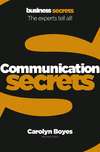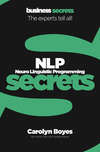Loe raamatut: «Communication»
Communication
Secrects
The experts tell all!
Carolyn Boyes

Table of Contents
Cover Page
Title Page
Communicate effectively in business
Firm foundations
1.1 Take responsibility
1.2 Watch your facts
1.3 Listen actively
1.4 Ask effective questions
1.5 ‘Chunk’ appropriately
1.6 Choose your words
Body basics
2.1 Stand out at first glance
2.2 Be aware of personal space
2.3 Practise your handshake
2.4 Use eye contact carefully
2.5 Show you’re friendly
2.6 Be authoritative
2.7 Be culturally appropriate
Team talk
3.1 Be aware of dynamics
3.2 Take people into your confidence
3.3 Show gratitude
3.4 Establish a rapport
3.5 Give good feedback
3.6 Be persuasive
3.7 Be a coach
Making the most of meetings
4.1 Plan and prepare
4.2 Pay attention to your audience
4.3 Stand (or sit) tall
4.4 Keep the discussion relevant
4.5 Be a story teller
4.6 Keep it short and sweet
4.7 Choose the right seat
Selling successfully
5.1 Be client-centred
5.2 Show your client what’s in it for them
5.3 Win others’ support
5.4 Communicate credibly
5.5 Know why clients say “no”
5.6 Fire the imagination
5.7 Understand values
5.8 Avoid “but” and “try”
5.9 Don’t think of a blue tree
5.10 Handle complaints flexibly
Dealing at a distance
6.1 Be a flexible speaker
6.2 Observe phone etiquette
6.3 Use emails thriftily
6.4 Stay professional
6.5 Don’t use emails as avoidance
Ditching the difficulties
7.1 Keep focused
7.2 Say “no” nicely
7.3 Control your emotions
7.4 Don’t interrupt
7.5 Challenge bad behaviour
7.6 Listen empathetically
7.7 Be a great negotiator
7.8 Avoid judgement
Jargon buster
Further reading
About The Author
Copyright
About the Publisher
Communicate effectively in business
Communication is at the heart of everything we do in business, yet poor communication is a huge problem for businesses and individuals, causing low morale, poor performance and high staff turnover. Much communication happens by accident, with the wrong messages coming across. If you want to be successful in business, it is worth learning about really good communication.
As a person working in international business throughout my career, I have seen how communication can help and hinder relationships within an organization, and impact on teams and goals for the business as a whole. Poor communication can cause stress and hardship for individuals within an organization.
With a background in languages and sales, I have always found words extremely important to me. People in business can earn big money from being skilled with words but can also lose their jobs if they have poor communication skills. Communication can often be distorted because people think they have said one thing but have really given a totally different message. During the last 10 years, as trainer of Neuro-Linguistic Programming, I have become aware of the deeper communication that goes on between individuals and groups through non-verbal communication. That’s why it’s important that all business people consider the secrets of communication.
This book consists of 50 secrets in total, divided into seven chapters.
Firm foundations. Shows you the essentials of communication you can take into any situation.
Body basics. Explains non-verbal communication and what to look out for.
Team talk. Gives you the run-down on communicating with your colleagues or your boss.
Making the most of meetings. Tells you what to do in a meeting or presentation.
Selling successfully. Gives you the secrets of how you can communicate effectively with clients.
Dealing at a distance. Helps you with the ins and outs of telephone calls and emails.
Ditching the difficulties. Puts you in charge of difficult communication situations.
Do not take good com munication for granted, but rather plan and practise your communication skills.
Firm foundations
Pay attention to the fundamentals of communication to get your message across in the way you want to, both for yourself and for your business. With good communication, you will avoid being misunderstood and expressing inconsistent or unclear messages, ideas, feelings and instructions. Instead, you will become more effective in your career and form stronger relationships with both colleagues and clients.
1.1 Take responsibility
Yes, it sounds basic, but most of us just open our mouths and speak without prior thought. Yet, whether you are talking or just standing around, you are communicating. So take responsibility. Everything you say and do gives a message in business about how you see yourself and your job.
It is said that we:
“Hear half of what is said; listen to half of that; understand half of that; believe half of that, and remember half of that.” (Anon)
Face to face or on the telephone, business is won and lost by communication. If you don’t communicate well enough to a customer or to your boss, you might lose money or your next promotion. The real communication is the message the other person picks up. Take these steps to make sure you always are in control of your message.
one minute wonder One of the first steps you can take to improve your communication is to make it two-way. Sometimes you need to hold back from telling others about all the wonderful things you know and start listening instead.
Use your ears. Remember, communication is not two monologues. If you are talking to someone, listen as well.
Take your time. Pause, ask questions, negotiate, sell, respect the other person’s point of view.
Get in tune. Good communicators are very flexible. They monitor the other person’s reactions and vary their delivery according to the understanding and background of the person.
Be focused. Have a reason to communicate. Don’t just open your mouth. What outcome do you want from your communication? If you know what you want, you are more likely to be focused in how you communicate.
Pay attention to the medium. In business, how you communicate is often as important as what you communicate.
Choose your approach. Will your message be more effective if you speak face to face, have a meeting or write an email?
Think before you speak. People who think through what they are going to say can be a rarity in business. Many people talk in order to form thoughts; they produce a lot of noise but without much purpose.
Develop your natural inquisitiveness. Good communicators are genuinely interested in listening as well as talking. They want to gain new knowledge and hear what the other person has to say.
Take responsibility for what you say and how you say it.
1.2 Watch your facts
One of the hazards in business conversations is falling into the habit of stating ‘fact’ after ‘fact’ in an assertive manner when the statements are really just opinions. To be clear in your communication and avoid misunderstandings, learn to distinguish your facts from opinions and assertions.
When you talk, there are only a few ways in which you can say something: by asking questions, stating facts or giving opinions. If you want to communicate well in business, you need to recognize when it is appropriate to be gentle, when you should be forceful and when to be probing and challenging.
Often people state facts or offer opinions when really they should be trying to pry out information through soft questioning. So let’s be clear: a fact is something that is specific enough that you can prove it with evidence.
Fact. “The economy grew by 10% year on year.”
Opinion. “I am always right and you are always wrong.”
one minute wonder To add authority to your voice, pay attention to your tone. Questions, statements and commands all have their own intonation. Avoid making statements where your voice rises up at the end of the phrase as this will sound as if you are questioning or doubtful. Statements sound strong when using a voice that is level or falls at the end.
The first statement is a fact and can be backed up with evidence. The second statement, on the other hand, is not a fact; it is an opinion. It is important that you don’t get confused between facts and opinions, whether as a manager or an employee, or when you are selling or negotiating. If you give an opinion, it should always be made clear, usually by saying something like, “in my opinion…” or “in my way of thinking…” as a way to introduce the theme. This allows the opportunity for discussion and others to hold different views to your own.
The poorest form of communication is the overuse of assertions, as an assertion is an opinion pretending to be a fact. Because they are not prefaced by any sign that they are an opinion, the other person is encouraged to accept them as being true even if there is no hard evidence to support them.
Weak communicators use assertions in order to close down debate and discussion. They close off any room for the other person in the conversation to give their opinion. Managers who use assertions all the time soon find that they are surrounded by ‘yes people’ while never really finding out what is going on in their organizations.
Distinguish facts from your opinions in conversations by making it clear when it is ‘just your view’.
1.3 Listen actively
Good listening skills are a vital element of good communication and help to build business relationships, whether in a team or when selling to a client. Most people think they listen, but, if you watch them closely, they are really simply working out what they are going to say as soon as they get an opportunity in the conversation.
Lots of people listen with their ‘mouths’ rather than their ears. They are not really listening at all. They are simply looking for a chance to speak so they can take control of the conversation – this is called selective listening.
Why is this so? They probably assume that they have more interesting, intelligent, knowledgeable or relevant things to say than the other person. Or they are mentally editing or criticizing what the other person is saying, and prejudging the outcome of the conversation.
In contrast, when you actively listen, you don’t jump to conclusions about what the speaker is saying but try to see things from the other person’s viewpoint. Real listening is not passive. It takes focus and energy, but the pay off is much improved communication. These are some steps you can take to listen actively:
“Silence is a source of great strength” Laozi, Chinese sage
1 Use body language. When you actively listen, you show the person through speech and body language that you are listening. Use eye contact and your facial expressions and gestures to show that you are listening.
2 Be curious. Don’t prejudge what the speaker wants to say. Be interested. What is the outcome they want? What is their motivation? What is the real reason they are talking to you?
3 Summarize. Repeat back what you think the speaker has just said to you. For example, “What I have heard you say is XXX.” This gives the speaker the opportunity to clarify any misunderstood areas.
4 Clarify any abstract or fuzzy terms as you go along. This assists the speaker to recognize any gaps in the information that they are giving you. You can say, “This is what I am hearing you saying? Is this right?”
5 Be silent when necessary. Silence is an important part of listening. Silences in the conversation give the other person time to explore and express their thoughts fully.
Listen actively and focus on the speaker’s message without prejudging the conversation.
1.4 Ask effective questions
Not enough people ask effective questions. Precise questions allow you to understand problems in a team or with your client, find out what’s going on beneath the surface, defuse problem situations before they fully arise, get people to cooperate with you, find out important information, negotiate and persuade people to help and support you.
If you want to improve your communication in any business situation, then become a great questioner. You can become much more effecive in many situations by asking the right questions. This is particularly useful in challenging situations, such as if a mistake has been made or if you want to get others to agree to an idea or proposal.
Powerful questions are generally open-ended, thought-provoking or probing. This means they can’t be answered with a simple yes or no answer.
‘What’ and ‘how’ questions draw out the other person and are most likely to get them to reveal their real opinions. Here are some examples you can use again and again:
“Effective questioning brings insight, which fuels curiosity, which cultivates wisdom”
Chip Bell, American writer
Information-seeking questions. These draw out additional information from the other person. “What do you mean by…?”, “Tell me more about…?”, “What else?”
Exploratory questions. These allow someone to think about different approaches: “Could you approach this in a different way?” “What are the possibilities here?”, “What are the opportunities here?”
Identifying a problem. “What seems to be the problem?”, “What is stopping you from…?”, “What is your main block?”, “What worries you most about…?”, “How do you feel about…?”
Outcome questions. “What outcome do you want?”, “If you have this, how will it effect you?”, “What other factors do you need to consider?”
Clarification. “What do you mean by…?”, “Could you put that another way?”, “Can you give me an example?”
Action. “What will you do?”, “When will you do it?”, “How will I know you did it?”, “What are your next steps?”
Response to ideas. “How does that sound to you?”, “What benefits do you think you will gain from…?”, “Does that answer the issue?”
Effective questioning combined with active listening form a fundamental set of communication skills for business.
1.5 ‘Chunk’ appropriately
Think about the people you work with. You’ll probably find that there are two types: big picture people and detail people. Big picture people like to hear little detail. Detail people don’t like discussing abstract concepts. Each type will only really take in what you say to them effectively if you communicate in the right-sized ‘chunk’ of detail.
The simplest way to think about this is that these two different types of thinkers process information in distinct ways. This is important to know and recognize if you want to influence other people with your communication.
Once you know the difference is there, look out for signs of how much detail or abstract information a person appears to be able to process, and respond flexibly in your communication.
Big picture people. Another term for big picture people is ‘global thinkers’. If you are communicating information to a global thinker, stop giving lots of detailed information and focus on the big picture. If you focus too much on detail, they will rapidly become bored or overwhelmed, and fail to either understand what you are saying or be
one minute wonder Your flexibility in communication will make an enormous difference to your effectiveness. Do you know what level of detail you like to communicate most? If you know your habits, you can challenge yourself to become a more flexible communicator.
influenced by you. The best thing to say to a global thinker is: “Here’s the big picture…”. Stay abstract and don’t give too many details. If you need to give detailed information, then give the big picture first: “Here’s the big picture…now I am going to give you some details.”
Detail people. Detail people, on the other hand, need to start with detail before they can become engaged with what you have to say about the wider idea. They can’t handle it if you start talking too conceptually. Say to them, “Here are the details.” Be specific and don’t use abstractions. If you need them to focus on the detail and keep an eye on the big picture, give them both in this way: “Here are the details…and here’s the big picture.”
Find out which members of your team and which of your clients like to communicate predominately in which way, and you will gain much more control over your communication.
Work out whether your team are big picture or detail communicators.
Tasuta katkend on lõppenud.















